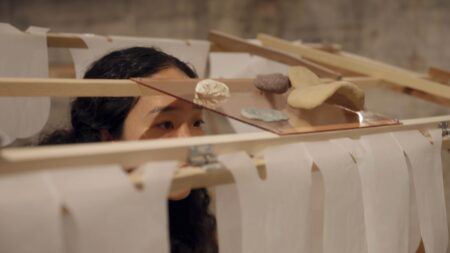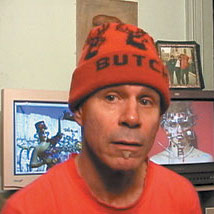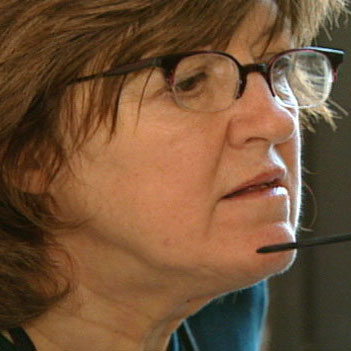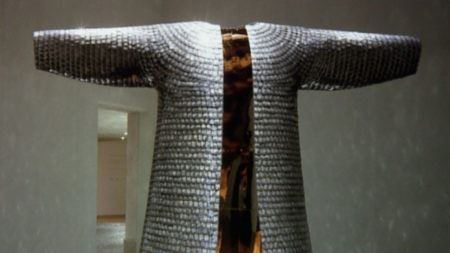Continue playing
(Time remaining: )
Play from beginning
Continue playing "{{ controller.videos[controller.getVideo(controller.currentVideo)].segmentParentTitle}}"
{{controller.videos[controller.getVideo(controller.currentVideo)].title}} has ended.
Time
Time is always present in our interaction with works of art, whether we sit to contemplate a painting, stroll past a sculpture, or watch a video piece for its entire duration or cycle. Some works of art are time-based in that the viewer must experience them through the passage of time, as with music, while others refer to time through links or references to art history, our collective human history, or the timelessness of nature. Filmed on location in China; Japan; New York, New York; San Antonio, Texas; Cambridge, Massachusetts; and Los Angeles, California.
More information and creditsCredits
Created by: Susan Sollins & Susan Dowling. Executive Producer & Curator: Susan Sollins. Series Producer: Eve-Laure Moros Ortega. Associate Producer: Migs Wright. Assistant Curator: Wesley Miller. Production Manager: Alice Bertoni & Laura Recht. Production Coordinator: Kelly Shindler & Sara Simonson. Director of Education & Outreach: Jessica Hamlin. Producer: Catherine Tatge. Editor: Joanna Kiernan. Host Segment Artist: Charles Atlas. Host: Merce Cunningham. Director of Photography: Bob Elfstrom, Dean Head, Gary Henoch, Mead Hunt, Tom Hurwitz, Ken Kobland, William Rexer, Nancy Schreiber, & Joel Shapiro. Sound: Brian Buckley, Gautum Choudhury, Doug Dunderdale, Alex Lamm, Eric Leung, Mark Mandler, Juan Rodriguez, Jerry Stein, JT Takagi, Bill Wander, & Merce Williams. Gaffer/Grip: William Arbuckle, Eric Boland, Jeff Panessa, Ken Shibata, & Andrew Wilson. Assistant Camera: Jarred Alterman, Marie Chao, Brian Hwang, Steve Nealey, Kipjaz Savoie, & Tam Yong Xing. Host Make-Up: Joanne Nöél. Production Assistant: Ronny Merdinger, Jo-ey Tang, & Jesse Whittle-Utter. Assistant Avid Editor: Geoff Gruetzmacher, Jeremy Siefer, & Lynn True. Still Photographers: Alice Bertoni & Bob Elfstrom.
Creative Consultant: Ed Sherin. Graphic Design & Animation: Open, New York. Animation, Visual Effects & Compositing: Spontaneous Combustion. On-Line Editor: Don Wyllie & Frame:Runner NYC. Composer: Peter Foley. Voice-Over Artist: Jace Alexander. Sound Editing: Margaret Crimmins, Greg Smith, & Dog Bark Sound. Sound Mix: Tony Volante & Soundtrack F/T. Animation Stand: Frank Ferrigno & Frame:Runner NYC.
Artworks courtesy of: Vija Celmins; Tim Hawkinson; Paul Pfeiffer; Martin Puryear; Ace Gallery; The Edward R. Broida Collection; MASS MoCA; McKee Gallery; Modern Art Museum of Fort Worth; & The Project, New York and Los Angeles. Archival footage courtesy of: Nancy Kelly &
TV Asahi Productions.
Special Thanks: ArtPace; The Art21 Board of Trustees; Asia Pacific Vision; Jamie Bennett; Cathy Blanchflower; Trevor Carlson; Maggie Choy; The Corcoran Gallery of Art; Cunningham Dance Foundation; Jeanne Englert; Tom James; Hiroko Kikuchi; Tim Lloyd; The Metropolitan Museum of Art; MIT List Visual Arts Center; Rashaad Newsome; Oliver Ranch; Paulson Press; Samantha Rippner; Susan Rogers; Masami Shiraishi; Tammie Tsang; Yumi Umemura; Whitney Museum of American Art; & Rebecca Wilhelms.
Interns: Sharon Ber, Elana Davidian, Eliza Geddes, Karmin Guzder, Ehren Joseph, Lisa Kalikow, Lila Kanner, Crystal Kui, Daniela Leonard, Ronny Merdinger, Parth Savla, Kristen Smith, Whitney Smith, Morgan Soloski, Jo-ey Tang, Asya Varshishky, Jesse Whittle-Utter, & Jeremy Zilar.
Public Relations: Kelly & Salerno Communications. Legal Counsel: Albert Gottesman. Bookkeeper: William Handy.
Major underwriting for Season 2 of Art in the Twenty-First Century is provided by National Endowment for the Arts, PBS, Corporation for Public Broadcasting, The Allen Foundation for the Arts, Agnes Gund and Daniel Shapiro, Bloomberg, The Jon and Mary Shirley Foundation, Nonprofit Finance Fund, JPMorgan Chase, The Andy Warhol Foundation for the Visual Arts, The Horace W. Goldsmith Foundation, New York Arts Recovery Fund, Peter Norton Family Foundation, New York Times Company Foundation, Dorothea L. Leonhart Foundation, and Elizabeth Firestone Graham Foundation.
Closed captionsAvailable in English, German, Romanian, Italian, Japanese, Korean, Chinese, Italian
Through the Art21 Translation Project, multilingual audiences from around the globe can contribute translations, making Art21 films more accessible worldwide.
Interested in showing this film in an exhibition or public screening? To license this video please visit Licensing & Reproduction.
Charles Atlas is a filmmaker and video artist who has created numerous works for stage, screen, museum, and television. Atlas is a pioneer in the development of media-dance, a genre in which original performance work is created directly for the camera. Many of Atlas’s works have been collaborations with choreographers, dancers, and performers, including Yvonne Rainer, Michael Clark, Douglas Dunn, Marina Abramovic, Diamanda Galas, John Kelly, and Leigh Bowery. Atlas acted as Consulting Director for “Art in the Twenty-First Century” (Seasons 2 through 5), creating the original opening programs for each hour-long segment of Season 2, as well as supervising the “Stories,” “Loss and Desire,” “Memory,” “Play,” “Protest,” and “Paradox” episodes.
Martin Puryear’s objects and public installations—in wood, stone, tar, wire, and various metals—are a marriage of minimalist logic with traditional ways of making. Puryear’s evocative, dreamlike explorations in abstract forms retain vestigial elements of utility from everyday objects found in the world. In the massive stone piece, Untitled, Puryear enlisted a local stonemason to help him construct a building-like structure on a ranch in northern California. On one side of the work is an eighteen-foot-high wall—on the other side, an inexplicable stone bulge. A favorite form that occurs in Puryear’s work, the thick-looking stone bulge is surprisingly hollow, coloring the otherwise sturdy shape with qualities of uncertainty, emptiness, and loss.
Paul Pfeiffer’s groundbreaking work in video, sculpture, and photography uses recent computer technologies to dissect the role that mass media plays in shaping consciousness. In a series of video works focused on professional sports—including basketball, boxing, and hockey—Pfeiffer digitally removes the bodies of the players from the games, shifting the viewer’s focus to the spectators, sports equipment, or trophies won. Presented on small LCD screens and often looped, these intimate and idealized video works are meditations on faith, desire, and a contemporary culture obsessed with celebrity. Many of Pfeiffer’s works invite viewers to exercise their imaginations or project their own fears and obsessions onto the art object.
Tim Hawkinson is renowned for creating complex sculptural systems through surprisingly simple means. His installation, Überorgan—a stadium-size, fully automated bagpipe—was pieced together from bits of electrical hardware and several miles of inflated plastic sheeting. The source of inspiration for many of Hawkinson’s pieces has been the re-imagining of his own body, and what it means to make a self-portrait of this new or fictionalized body. In 1997, the artist created an exacting, two-inch-tall skeleton of a bird from his own fingernail parings; believable even at a close distance, this work reveals Hawkinson’s attention to detail as well as his obsession with life, death, and the passage of time.
Vija Celmins received international attention early on for her renditions of natural scenes—often copied from photographs that lack a point of reference, horizon, or discernable depth of field. Armed with a nuanced palette of blacks and grays, Celmins renders these limitless spaces—seascapes, night skies, and the barren desert floor—with an uncanny accuracy, working for months on a single image. Celmins has a highly attuned sense for organic detail and the elegance of imperfection. A master of several mediums, including oil painting, charcoal, and multiple printmaking processes, Celmins matches a tangible sense of space with sensuous detail in each work.
“I’m really interested in vernacular cultures where people lived a little closer to the source of materials…”
Martin Puryear






